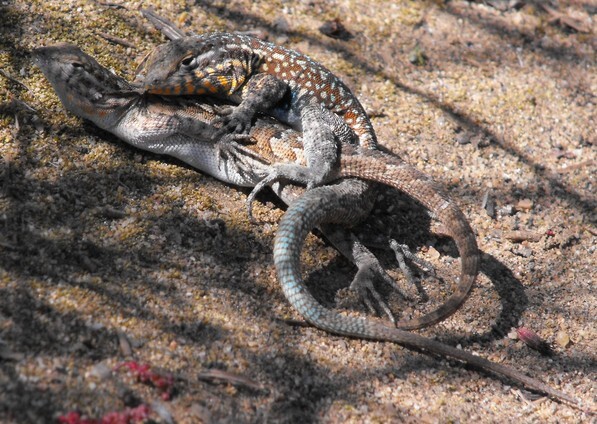California Desert's Commonest Lizard Has Uncommon Evolutionary Lesson in Store

If you've ever gone for a walk on a warm day on a narrow desert trail, you've almost certainly noticed little lizards scurrying away from you just as you arrive at their hiding places. Most of the time you wouldn't have seen them if they'd stayed put in the rocks or vegetation along the trail, but something hard-wired into their brains makes them burst out into the open as you pass.
More often than not in the California desert, this panic-attacked scurrier is a common side-blotched lizard (Uta stansburiana), which is one of the most common lizards in the desert -- and the species most likely to be enjoying the same sunny afternoon you are. But this lizard isn't just a pleasant companion on walks; it's one of the niftiest evolutionary curiosities the desert has to offer.
Generally about two and a half inches from tip of nose to base of tail, with undamaged tails about as long, the side-blotched lizard is best identified by -- you guessed it -- a dark blotch on either side of its abdomen, just behind the forelegs, about where its elbows would touch is sides. The blotch isn't always there, and when it is it may be hard to see, especially if the lizard you're trying to identify is dark all over. Overall patterns and coloration vary from light with irregular speckles, or herringbone patterns like those you might find on a fence lizard, to nearly coal-black.
The side-blotched ranges from the tip of Baja California north to the environs of Yakima, with populations along the California coast and in the southwestern Great Plains, from the Mexican states of Durango and Zacatecas to New Mexico, Texas and a smidgen of Oklahoma.

Given the wide geographic range of the species and the seriously confusing degree of variation in appearance, it's not at all surprising to find that herpetologists are in near-continual discussion over whether the species Uta stansburiana should be split up into new species or subspecies, and how many of them there should be, and which groups of lizards belong to each. Many authorities list four subspecies of Uta stansburiana, some of which have been split into their own species, then added back into U. stansburiana again. As the surprisingly accurate Wikipedia entry on the species states,
The systematics and taxonomy of these widespread and variable lizards is much disputed. Countless forms and morphs have been described as subspecies or even distinct species.
As if to underscore that confusion, Wikipedia's entry on the broader genus Uta lists a dozen other species that were once or may be in the future folded into U. stansburiana.
A lot of confusion for a tiny lizard. But scientists don't argue about taxonomy just to be impenetrable. Their goal is to represent as accurately as possible, using the inherently imprecise tool of human language, the evolutionary history of each group of lizards. It seems almost inevitable that the more we learn about side-blotched lizards' genetic makeup, the more new species herpetologists will eventually agree upon.
One thing we've learned about the genetic diversity of common side-blotched lizards qualifies as an honest-to-god Wonder of Nature.
During mating season, male side-blotched lizards become significantly more colorful, with throat patches blooming in one of three general shades: orange, blue, and yellow. About 15 years ago herpetologist Barry Sinervo and his colleagues at UC Santa Cruz noted that differences in throat color among male side-blotcheds corresponded with differences in mating strategy.
Orange, blue, and yellow. | Image courtesy Barry Sinervo
Orange-throated side-blotched lizards, which tend to be somewhat larger than their counterparts, are aggressive and can defend large breeding territories that may host two or more females. The yellow-throated guild are smaller, generally unable to defend much territory at all, and mainly mate by way of sneaking into other males' territories -- where their small size and paler coloration may actually help them pass as female. In the mid-weight class stand the blue-throated lizards, which generally choose a single mate and stick close to her, guarding her against incursions from competing males.
The result of this set of behaviors, all seemingly determined by a single gene, is that larger orange males can beat blue ones in competition over females, but are often bested by "sneaky" yellow-throated males. Yellow-throated males have less luck getting past blue-throats, who guard their mates carefully.

In other words, orange beats blue, which beats yellow, which beats orange, in a reptilian manifestation of the old "rock, paper, scissors" game.
This rochambeau relationship doesn't just apply to individual interactions, but can shape the nature of entire populations. If one color starts to predominate in an area, that gives its superior a reproductive edge. A stretch of desert dominated by orange-throated males is a very good place to be a yellow-throated male, because you have a much better chance of mating. Over a few years yellows will supplant oranges, which gives the few remaining blue-throats an increasing reproductive edge. And so many populations of side-blotched lizards will cycle through male throat colors over a period of a decade or two. The majority of the males on the slopes above Palm Springs in the last few years have been blue-throats, though this year so far I've noticed more orange throats than I did last year. If I come back in 2019 there will likely be a lot of small, yellow-throated male side-blotched lizards.
What about the females? As is the case for studies of human beings, where we only recently discovered certain basic facts about women's reproductive anatomy, there are a lot of things about female side-blotched lizard reproductive behavior that we don't know yet. Throat color does seem to play a role in aspects of sex other than behavior, though. Orange-throated females seem to have lots of small offspring, while yellow-throats have fewer young of more robust fitness.
In any event, this cycling through orange, blue, and yellow throated males seems to be an extraordinarily efficient way of maintaining genetic diversity over very long periods of time. Each trait stays present in the population waiting its turn to dominate. The cycle is a metaphorical flywheel that creates genetic stability in the larger population. In 2010 UC Santa Cruz researchers published a study showing that if one of those three traits is eliminated from a population, that "flywheel" goes wobbly and rapid evolution away from the previous genetic equilibrium commences, perhaps leading to new species of side-blotched lizard.
It's a nifty reminder that simple traits can create stunningly complex systems, and something to think about the next time you see a quick glimpse of blue throat dart away from your boot at the very last minute. Or orange throat. Or yellow. Or blue.
Chris Clarke is an environmental writer of two decades standing. Author of Walking With Zeke, he writes from Palm Springs regularly at his acclaimed blog Coyote Crossing and comments on desert issues on KCET weekly. Read his recent posts here.


